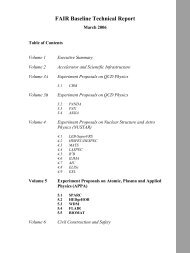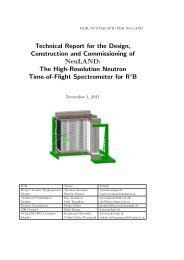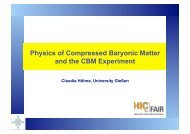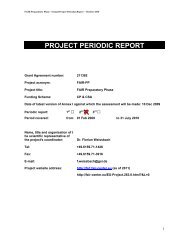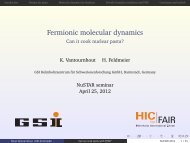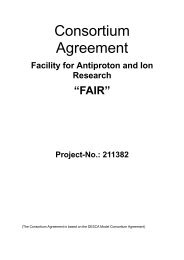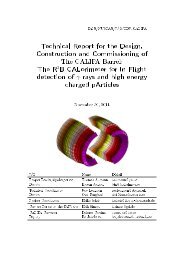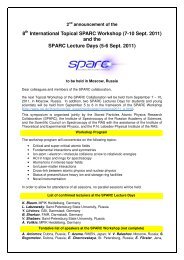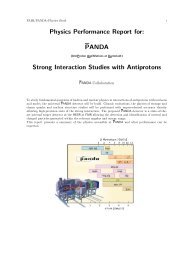Clustering algorithms for CBM calorimeter
Clustering algorithms for CBM calorimeter
Clustering algorithms for CBM calorimeter
You also want an ePaper? Increase the reach of your titles
YUMPU automatically turns print PDFs into web optimized ePapers that Google loves.
<strong>Clustering</strong> <strong>algorithms</strong><br />
<strong>for</strong> the <strong>CBM</strong> <strong>calorimeter</strong><br />
Mikhail Prokudin
Outline<br />
►Why Why we need clustering<br />
Reconstruction in <strong>calorimeter</strong><br />
►<strong>CBM</strong> <strong>CBM</strong> <strong>calorimeter</strong><br />
Electron and muon option<br />
“Common Common” clustering procedure<br />
Cluster finding in electron option<br />
Cluster finding in muon option
Reconstruction in <strong>calorimeter</strong><br />
► Photon reconstruction<br />
Energy<br />
Position<br />
►Momentum: Momentum: all photons from primary vertex<br />
► General case<br />
Just single photon reconstruction<br />
► LHC<br />
Single photon/pair from π0 decay?<br />
► Heavy ion experiments<br />
Shower overlaps (occupancy)<br />
►energy energy deposition from different photons in one cell<br />
►shower shower shape and fitting <strong>for</strong> unfolding
Requrements<br />
►Cluster Cluster should be large<br />
in<strong>for</strong>mation <strong>for</strong> unfolding procedure<br />
►Cluster Cluster should be small<br />
fitting of 2 clusters with 2 photons each is much<br />
faster than fitting 1 cluster with 4 photons<br />
►…<br />
and results are more accurate<br />
minimize contamination of hadrons<br />
not less than 3 cells per photon<br />
►3 3 free parameters
Calorimeter in <strong>CBM</strong> experiment<br />
Electron option<br />
Muon option
►<br />
Electron option<br />
Distance to target: 12 m<br />
Cell size: 3×3, 3 3, 6×6, 6 6, 12×12 12 12 cm<br />
Sampling: 140 layers (25X 0)<br />
► 1.0 mm lead<br />
► 1.0 mm scintillator<br />
Acceptance: 5-25 5 25°<br />
Energy resolution: 7%/sqrt(E)<br />
~14000 readout channels<br />
Geometry<br />
►<br />
Muon option<br />
Distance to target: 1.5 m<br />
Cell size: 2.5×2.5 2.5 2.5 cm<br />
Sampling: 70 layers (20X 0)<br />
► 1.0 mm tungsten<br />
► 1.5 mm scintillator<br />
Acceptance: 5-45 5 45°<br />
Energy resolution 7.6%/sqrt(E)<br />
~8000 readout channels<br />
Calorimeter of muon option could be used as a central <strong>calorimeter</strong><br />
region in electron option.
►<br />
►<br />
►<br />
►<br />
Cluster finding. Naive approach<br />
Cluster definition:<br />
connected area of cells with<br />
energy deposition above the<br />
threshold<br />
threshold can be found from MC<br />
Occupancy differs ~10 2 times<br />
<br />
► partially compensated by<br />
segmentation<br />
lost clusters in periphery of<br />
<strong>calorimeter</strong><br />
create too large clusters in central<br />
region<br />
No chance to fit cluster with >7 ><br />
peaks<br />
central region is lost!<br />
Clusters with size
Cluster finding<br />
► Find peak above threshold<br />
peaks associated with charged track are removed from the<br />
consideration<br />
► Construct a subcluster<br />
around the peak<br />
with certain number of cells<br />
it should contain 2×2 2 2 submatrix with maximum energy of<br />
3×3 3 matrix around peak<br />
add a cell from 3×3 3 3 matrix with minimum energy deposition<br />
►adds adds in<strong>for</strong>mation <strong>for</strong> unfolding<br />
► Cluster is a set of preclusters<br />
with common cells
Naive<br />
Peaks per cluster<br />
Comparison<br />
Au+Au 25AGeV<br />
Number of peaks per cluster lower using new approach<br />
<strong>CBM</strong>
AuAu<br />
25 GeV<br />
► 35% reconstruction<br />
efficiency<br />
► Boundaries between<br />
<strong>calorimeter</strong> regions<br />
occupancy<br />
UrQMD<br />
events<br />
Reconstruction efficiency vs. θ and energy
Cluster finding in muon option<br />
►Main Main difference with electron option:<br />
small (2.5 ( 2.5×2.5 2.5 cm) cm)<br />
cell size and large (up to 45<br />
impact angle<br />
►Keep Keep general procedure<br />
►maximum maximum location<br />
►precluster precluster <strong>for</strong>mation<br />
►cluster cluster is a set of preclusters<br />
with common cells<br />
… but use a shower shape <strong>for</strong> precluster<br />
<strong>for</strong>mation<br />
►shower shower is “more more long than wide” wide<br />
precluster size as a parameter<br />
►small small clusters in inner regions and large in outer<br />
)<br />
45°)
► Parameters<br />
cluster size<br />
Precluster <strong>for</strong>mation<br />
►keep keep as low as possible<br />
semiaxes of ellipse<br />
distance from center of<br />
mass to ellipse center<br />
Y, cm 9 cell cluster<br />
2×2 cluster<br />
Ephoton=16 GeV, Angle=35°<br />
X, cm
Cluster size<br />
16 GeV<br />
photons<br />
2x2 7 9
Cu+Cu 25 GeV<br />
Au+Au 25 GeV<br />
Average energy deposition per event<br />
Average energy deposition per event<br />
GeV<br />
GeV
Conclusions<br />
►3 3 <strong>algorithms</strong> of clustering was presented<br />
“common common” one does not work<br />
►occupancy occupancy variations<br />
…clusters clusters constructed near maximums of<br />
energy deposition<br />
..use of shower shape <strong>for</strong> large impact angles<br />
and small cell size





